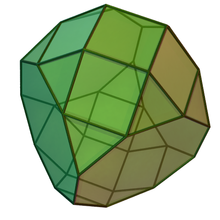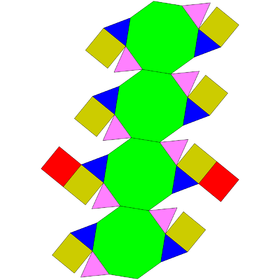Biaugmented truncated cube
Appearance
| Biaugmented truncated cube | |
|---|---|
 | |
| Type | Johnson J66 – J67 – J68 |
| Faces | 2x8 triangles 2+8 squares 4 octagons |
| Edges | 60 |
| Vertices | 32 |
| Vertex configuration | 8(3.82) 8(3.43) 16(3.4.3.8) |
| Symmetry group | D4h |
| Dual polyhedron | - |
| Properties | convex |
| Net | |
 | |
In geometry, the biaugmented truncated cube is one of the Johnson solids (J67). As its name suggests, it is created by attaching two square cupolas (J4) onto two parallel octagonal faces of a truncated cube.
A Johnson solid is one of 92 strictly convex polyhedra that is composed of regular polygon faces but are not uniform polyhedra (that is, they are not Platonic solids, Archimedean solids, prisms, or antiprisms). They were named by Norman Johnson, who first listed these polyhedra in 1966.[1]
External links
[edit]- ^ Johnson, Norman W. (1966), "Convex polyhedra with regular faces", Canadian Journal of Mathematics, 18: 169–200, doi:10.4153/cjm-1966-021-8, MR 0185507, Zbl 0132.14603.
